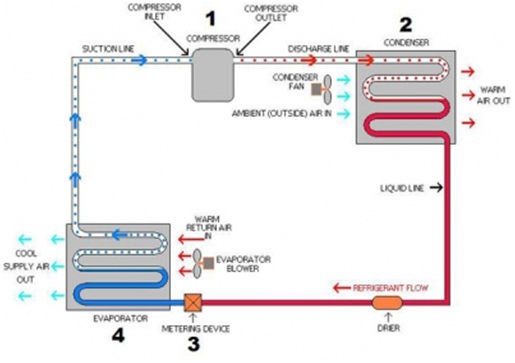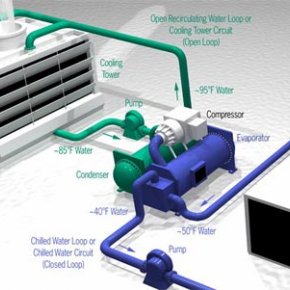Basic Air Conditioner System
Last updated: 18 ก.พ. 2556 | 6009 จำนวนผู้เข้าชม |

Basic Air Conditioner System
FOLL OW
All air conditioning systems contain the same basic componentscompressor, a condenser, a dryer, a metering device, and an evaporator.
Air Conditioner Component and Cycle Diagram
The Compressor (Figure 1)
The heart of every air conditioner system- automotive air conditioner, home window air conditioner, or central air conditioner-is the compressor. Residential systems use a hermetically sealed compressor unit. Hermetically sealed compressors combine an electric motor and compressor in a single unit. Automotive air conditioning systems use a radial compressor powered by the car engine. The compressor takes in low-pressure gas at its "Inlet," compresses it, and discharges it as a high-pressure gas at its outlet. The pressures involved are different for different refrigerants. For refrigerant R134a, the environmental refrigerants used in modern automotive air conditioners, the suction side pressure is between 25 and 40 psi and the discharge side, the high side, pressure is between 225 and 250 psi.
The Condenser (Figure 2)
The condenser take in the high pressure gas, represented by the red dots in the drawing, and changes its state to a liquid, represented by the solid red in the drawing. The change of state occurs when the temperature of the refrigerant is 25 to 30 degrees higher than the ambient temperature. If the outside temperature is 90 degrees, the change of state occurs when the refrigerant is between 105 and 120 degrees. The air flowing through the condenser cools the gas and causes it to change state from gas to liquid, the condenser fan in a home air conditioner is powered by a small electric motor, in a car, it is the same fan that forces air through the engine's radiator.
The Dryer
The liquid refrigerant leaving the condenser passes through a "Dryer" on its way to the evaporator. A dryer may be a stand-alone component as shown in this basic diagram, or it may be part of an accumulator/dryer or receiver/dryer. Whatever configuration the dryer takes, it serves the same purpose removing water vapor from the refrigerant. The dryer contains a desiccant that absorbs water. The dryer is the component that is replaced every time the system is opened up for repairs.
The Metering Device (Figure 4)
The metering device may be an expansion valve or an orifice tube. An expansion valve and an orifice tube work differently but they serve the same purpose. As the liquid refrigerant passes through the metering device, its pressure drops from around 225 psi to about 70 psi. As the pressure decreases, the temperature of the refrigerant drops from around 110 degrees to around 40 degrees. At 40 degrees Fahrenheit, refrigerants start to evaporate causes an even greater drop in temperature. As warm air flows through the evaporator, the cold refrigerant gas absorbs heat. The heated gas is returned to the compressor through the suction line represented by the blue dots.
At the risk of having over simplified the physics of refrigeration, there you have it. Maybe I wall do an article, or even several articles on the physics involved at some point in the future.
เนื้อหาที่เกี่ยวข้อง
Chiller Basic
7 ก.พ. 2556
